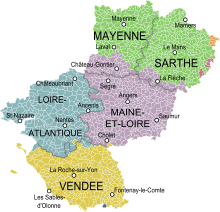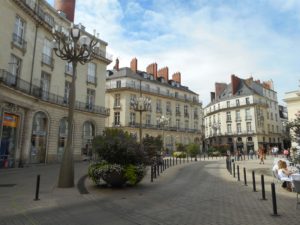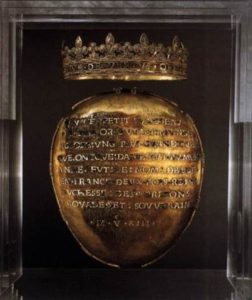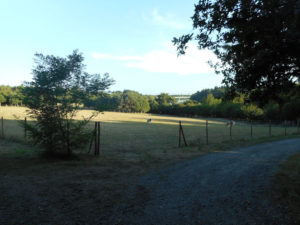The Sèvre Nantaise is a river in western France, a left-bank tributary to the Loire. Its total length is 142 km. Its source is in the Deux-Sèvres département, near Secondigny.
CLICK Refresh FOR SLIDES
The Sèvre Nantaise is a river in western France, a left-bank tributary to the Loire. Its total length is 142 km. Its source is in the Deux-Sèvres département, near Secondigny.
CLICK Refresh FOR SLIDES

Grand old gardens seem to assert the outer borders of Nantes in each direction but it is to the North that is located a roseraie for all seasons with ample flowering year round, baroque old roses in the warmer months aside hardy new roses which still flower in the cold months. One could live in Nantes for this garden alone.




The Pays de la Loire region is a recent creation, not one of France’s historic regions. Indeed, the regional capital, Nantes, was once the capital of Brittany – to which it no longer belongs. In historic terms, Pays de la Loire covers parts of the old provinces of Brittany, Anjou, Maine and Poitou. The Pays de la Loire covers the area to the south of Brittany and Normandy, along the lower stretches of the river Loire, the longest river in France.
The region is composed of five departments, two of them coastal – the Loire Atlantique (44) and the Vendée (85) – and three of them inland, the Mayenne (53), the Sarthe (72) and the Maine et Loire (49).

Nantes (44), the regional capital is the sixth largest city in France, with 270,000 inhabitants in the urban borough of Nantes, and an estimated 800,000 inhabitants in the urban area as of 2008. It is located on the Loire, 50 km inland, and is the largest economic hub in the north west of France. In the eighteenth century, Nantes (like Bristol) was a flourishing seaport, indeed the most important seaport in France; the city acquired great wealth at that time, wealth which is reflected to this day in its urban heritage. Today, most of the shipping activity has moved to the mouth of the Loire, to the port of Saint Nazaire, which is also one of the major ship-building cities in Europe. It was in the Saint Nazaire dockyards that the new flagship of the Cunard line, the world’s largest passenger ship, the Queen Mary 2, was built. A clear birds-eye view of the shipyards can be had from the Pont de Saint Nazaire, the high road bridge that spans the Loire estuary. (Originally a toll bridge, this bridge is now free to cross).
On the coast of the Loire Atlantique department lie two of France’s historic seaside resorts, La Baule and Le Croisic. The area round Le Croisic is also famous for its salt pans, and “sel de Guérande” is one of the best-known types of salt in France. The town of Guérande is a delightful small ancient walled city, just inland from the salt marshes.
South of the Loire Atlantique department lies an area known as Vendée. The modern department (85) is much smaller than the historic area that once carried this name. Vendée is famous in the history of France as one of the old bastions of Protestantism; after the revocation of the Edict of Nantes in 1685, and the end of religious tolerance, tens of thousands of Vendéen protestants fled from this part of France, and went to live in England, or America. Thus many people in England can trace some of their ancestry back to this part of France.
After the French Revolution, Vendée was a centre for the royalist counter-revolution.
The department is largely flat in the northern coastal area, low-lying and gently undulating inland. The capital, the city of La Roche sur Yon, is a small rural city in the middle of the department. The coast is built up round the seaside resorts, notably the fine beaches at les Sables d’Olonne, Saint Gilles Croix-de-Vie and St. Jean de Monts, but elsewhere there are stretches of empty coastline. In parts, a band of pine forests, planted on land that was once sand dunes, protects the flat farmland behind from the Atlantic winds and the sand – and protects it against flooding when Atlantic storms batter the coastline.
Further inland, the department of Maine et Loire (49) covers a territory to the north and south of the Loire.This is the heart of the region known as Anjou, and its capital Angers is one of the great historic cities in the Loire valley. Anjou was the fief of the Angevins, better known as the Plantagenets, who, starting with Henry II, ruled England for three centuries. The great castle of the counts of Anjou, in Angers, is one of the biggest medieval fortresses in Europe. Henry II, his wife Eleanor of Aquitaine, and their son Richard the Lionheart are buried at the Abbey of Fontevraud, between Saumur and Chinon.
The two remaining departments of this region, Sarthe (72) and Mayenne (53) form the rest of the old provinces of Anjou and Maine, and border on Normandy. Rural departments, and strongly agricultural, they both have more in common with Normandy than they do with Vendée. Half the population of the department of the Sarthe lives in the urban area round the capital, Le Mans, famous for its annual motor race. Apart from that, the Sarthe is deeply rural. La Flèche, an attractive small town on the river Loir (without an -e !) boasts one of the best and oldest zoos in France, coverning some 30 acres. Laval, capital of the Mayenne, is a small city with a historic centre. The city is located on the banks of the river Mayenne, which crosses the department from north to south, a navigable waterway with opportunities for boat hire, and 85 km of towpath idel for cyclists and hikers. The department of the Mayenne also boasts the highest point in the northwest quarter of France, the summit of the Mont des Avaloirs, at 417 metres, about 1350 ft.

Map of the Pays de la Loire with its five departments
showing the provinces that existed on its territory in the XVIII century.

Before my arrival in Nantes, France I was surprised by the nod of approval given by French people in Australia. It has a population of 200,000 people making it lively while retaining a beautiful sense of space and though one of my earliest experiences of small French cities, I expect Nantes to remain as my benchmark for assessing the quality of life in all other places.

History (Britannica)
Nantes, city, Loire-Atlantique département, Pays de la Loire région, western France. Nantes is situated at the head of the estuary of the Loire River, where it is joined by the Erdre and the Sèvre rivers, 35 miles (56 km) from the sea and southwest of Paris. It is one of the French towns that has changed the most in the 20th and 21st centuries.
Nantes derives its name from the Namnètes, a Gallic tribe who made it their capital. It became a commercial centre under the Romans. The Normans, after pillaging the town, occupied it from 834 to 936. After a long struggle in the Middle Ages between the counts of Nantes and Rennes for the sovereignty of Brittany, in 1560, Francis II, king of France (1559–60), granted Nantes a communal constitution. During the Wars of Religion (1562–98), Nantes joined the Catholic League and only opened its gates to Henry IV, king of France (1589–1610), in 1598, the same year he signed the Edict of Nantes, a charter assuring religious and civil liberties to the Protestants. During the French Revolution, Nantes suffered the ruthless repression of an envoy of the revolutionary Committee of Public Safety named Jean-Baptiste Carrier. In 1793 Carrier replaced executions by the guillotine, which he considered too slow, with mass drownings. The city was occupied by the Germans during World War II.
Greatly modified by an urban renewal plan that was adopted in 1920, Nantes was further altered and extended after having been partly destroyed in World War II. In the 1960s Nantes was designated as one of the eight provincial counterweights to reduce the dominance of Paris on French national life. It has become a dynamic regional centre, with a diversified economic structure. Traditional industries such as food processing, engineering, and the manufacture of components for the aeronautical industry remain important, but recent growth has occurred in fields such as biotechnology. A large scientific park, created in 1987, was designed to foster these activities. Nantes is also a major business centre and is the home of many regional headquarters of both industrial and services firms. A number of public and private sector offices have relocated from Paris to the city. Nantes has a large higher education section. The original university (founded 1460) was abolished during the French Revolution, but a new one was established in 1961. Tourism has been stimulated by redevelopment of part of the former docklands and the building of specialized conference facilities.
CLICK Refresh FOR SLIDES
I won’t ever forget the exhilaration during my first Summer in France as I discovered the manor and its Japanese garden reached via a park which shared an overgrown boundary with the rear of our garden. I came to it unexpectedly under the huge Japanese elm at the end of three kilometers of cow paddocks and shady riverbank paths, somewhere between lazy suburbia and heaven. We sat and ate cake from an old painted cake tin and I knew there and then, I was in France. The soft shadows of the glades give way to remnants of an industrial past.

Before my arrival in Nantes in Western France I was surprised by the nod of approval given by French people in Australia. It has a population of 200,000 people making it lively while retaining a beautiful sense of space and though one of my earliest experiences of small French cities, I expect Nantes to remain as my benchmark for assessing the quality of life in all other places.

During my first Summer I experienced France at some of the finest moments, the long sweeping shadows of the Chantrerie defining the late afternoon, small sparkling flower heads leaning in as we lunched alone on the rear manor house steps oblivious to any activity the caryatids behind us had witnessed in centuries past. Nantes is visible only as a sole highrise, its only high rise tower, occupying a small spot at the centre of the horizon, the forest in the foreground and the Erdre River in the mid ground.